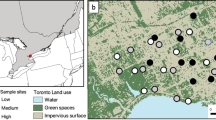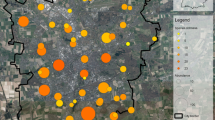Abstract
A bee’s ability to return home, its homing ability, can be used as a proxy for the maximum foraging distance of that species. Body size is hypothesized to affect foraging distance with larger bees having larger foraging ranges. In this study, we estimated the maximum foraging distance of six different afrotropical stingless bee species (Meliponula bocandei, Meliponula ferruginea, Meliponula togoensis, Meliponula beccarii, Plebeina armata and Hypotrigona gribodoi.) in two different landscapes (urban and natural). We conducted translocation experiments in which marked bees were released at different distances. Time of return and number of bees that returned to the hive were recorded. Our findings showed that the maximum homing distance of the studied bees in an urban landscape ranged between 400 and 800 m, while in a natural landscape it ranged between 800 and 1800 m. The distance at which 50% of the released bees returned, was found to range between 200 and 400 m in an urban and 400–1200 m in a natural landscape. It is plausible that the shorter range in an urban landscape is caused by urban beekeepers feeding their bees close to the colonies, so the urban bees are less likely to forage at greater distances. In addition, artificial structures such as tall buildings, electrical posts, as well as busy traffic, could possibly interfere with the foraging behavior of bees in urban landscapes. The rate of return was higher for closer distances up to 400–600 m in urban and natural landscapes, respectively. Our study suggests that urban beekeepers could assist their bees by cultivating diverse flowering plants close to colonies.



Similar content being viewed by others
Data availability
Data used in this study is contained within the article and is freely available upon request from the corresponding author.
References
Araujo ED, Costa M, Chaud-Netto J, Fowler HG (2004) Body size and flight distance in stingless bees (Hymenoptera: Meliponini): inference of flight range and possible ecological implications. Braz J Biol 64:563–568. https://doi.org/10.1590/S1519-69842004000400003
Bates AJ, Sadler JP, Grundy D, Lowe N, Davis G, Baker D, Bridge M, Freestone R, Gardner D, Gibson C, Hemming R, Howarth S, Orridge S, Shaw M, Tams T, Young H (2014) Garden and landscape-scale correlates of moths of differing conservation status: Significant effects of urbanization and habitat diversity. PLoS ONE. https://doi.org/10.1371/journal.pone.0086925
Bordier C, Pioz M, Crauser D, Le Conte Y, Alaux C (2017) Should I stay or should I go: honeybee drifting behaviour as a function of parasitism. Apidologie 48(3):286–297. https://doi.org/10.1007/s13592-016-0475-1
Campbell AJ, Gomes RLC, da Silva KC, Contrera FAL (2019) Temporal variation in homing ability of the neotropical stingless bee Scaptotrigona aff. postica (Hymenoptera: Apidae: Meliponini). Apidologie 50(5):720–732. https://doi.org/10.1007/s13592-019-00682-z
Capaldi EA, Dyer FC (1999) The role of orientation flights on homing performance in honeybees. J Exp Biol 202(12):1655–1666. https://doi.org/10.1242/jeb.202.12.1655
Chittka L, Williams NM, Rasmussen H, Thomson JD (1999) Navigation without vision: bumblebee orientation in complete darkness. Proc R Soc B Biol Sci 266(1414):45–50. https://doi.org/10.1098/rspb.1999.0602
Costa L, Nunes-Silva P, Galaschi-Teixeira JS, Arruda H, Veiga JC, Pessin G, de Souza P, Imperatriz-Fonseca VL (2021) RFID-tagged amazonian stingless bees confirm that landscape configuration and nest re-establishment time affect homing ability. Insectes Soc 68(1):101–108. https://doi.org/10.1007/s00040-020-00802-4
Couvillon MJ, Schürch R, Ratnieks FLW (2014) Waggle dance distances as integrative indicators of seasonal foraging challenges. PLoS ONE 9(4):1–7. https://doi.org/10.1371/journal.pone.0093495
Desaegher J, Nadot S, Fontaine C, Colas B (2018) Floral morphology as the main driver of flower-feeding insect occurrences in the Paris region. Urban Ecosystems 21(4):585–598. https://doi.org/10.1007/s11252-018-0759-5
Dicks LV, Breeze TD, Ngo HT, Senapathi D, An J, Aizen MA, Basu P, Buchori D, Galetto L, Garibaldi LA, Gemmill-Herren B, Howlett BG, Imperatriz-Fonseca VL, Johnson SD, Kovács-Hostyánszki A, Kwon YJ, Lattorff HMG, Lungharwo T, Seymour CL, Potts SG (2021) A global-scale expert assessment of drivers and risks associated with pollinator decline. Nat Ecol Evol 5(10):1453–1461. https://doi.org/10.1038/s41559-021-01534-9
Dramstad WE, Fry GLA, Schaffer MJ (2003) Bumblebee foraging—is closer really better? Agr Ecosyst Environ 95(1):349–357. https://doi.org/10.1016/S0167-8809(02)00043-9
Gathmann A, Tscharntke T (2002) Foraging ranges of solitary bees. J Anim Ecol 71(5):757–764. https://doi.org/10.1046/j.1365-2656.2002.00641.x
Greenleaf SS, Williams NM, Winfree R, Kremen C (2007) Bee foraging ranges and their relationship to body size. Oecologia 153(3):589–596. https://doi.org/10.1007/s00442-007-0752-9
Guédot C, Bosch J, Kemp WP (2009) Relationship between body size and homing ability in the genus Osmia (Hymenoptera; Megachilidae). Ecol Entomol 34(1):158–161. https://doi.org/10.1111/j.1365-2311.2008.01054.x
He X, Wang W, Qin Q, Zeng Z, Zhang S, Barron AB (2013) Assessment of flight activity and homing ability in Asian and European honey bee species, Apis cerana and Apis mellifera, measured with radio frequency tags. Apidologie 44(1):38–51. https://doi.org/10.1007/s13592-012-0156-7
Heinze S (2017) Unraveling the neural basis of insect navigation. Curr Opin Insect Sci 24(58):67. https://doi.org/10.1016/j.cois.2017.09.001
Hrncir M, Maia-Silva C (2013) On the diversity of foraging-related traits in stingless bees. In: Vit P, Roubik DW, Pedro SRM (eds) Pot-honey: a legacy of stingless bees. Springer
Hrncir M, Jarau S, Zucchi R, Barth FG (2003) A stingless bee [Melipona seminigra] uses optic flow to estimate flight distances. J Comp Physiol A Neuroethol Sens Neural Behav Physiol 189(10):761–768. https://doi.org/10.1007/s00359-003-0448-5
Jarau S (2009) Chemical communication during food exploitation in stingless bees. Food exploitation by social insects: ecological behavioral and theoretical approaches. CRC Press, Boca Raton. https://doi.org/10.1201/9781420075618
Jasna K, Stefan F (2006) Parasitic Varroa destructor mites influence flight duration and homing ability of infested Apis mellifera foragers *. Apidologie 37(5):577–587
Kuhn-Neto B, Contrera FAL, Castro MS, Nieh JC (2009) Long distance foraging and recruitment by a stingless bee. Melipona mandacaia Apidologie 40(4):472–480. https://doi.org/10.1051/apido/2009007
Leonhardt SD (2017) Chemical ecology of stingless bees. J Chem Ecol 43(4):385–402. https://doi.org/10.1007/s10886-017-0837-9
Leonhardt SD, Kaluza BF, Wallace H, Heard TA (2016) Resources or landmarks: which factors drive homing success in Tetragonula carbonaria foraging in natural and disturbed landscapes? J Comp Physiol A Neuroethol Sens Neural Behav Physiol 202(9–10):701–708. https://doi.org/10.1007/s00359-016-1100-5
Li Z, Chen Y, Zhang S, Chen S, Li W, Yan L, Shi L, Wu L, Sohr A, Su S (2013) Viral infection affects sucrose responsiveness and homing ability of forager honey bees Apis mellifera L. PLoS ONE 8(10):1–10. https://doi.org/10.1371/journal.pone.0077354
Menzel R, Geiger K, Joerges J, Müller U, Chittka L (1998) Bees travel novel homeward routes by integrating separately acquired vector memories. Anim Behav 55(1):139–152. https://doi.org/10.1006/anbe.1997.0574
Menzel R, De Marco RJ, Greggers U (2006) Spatial memory, navigation and dance behaviour in Apis mellifera. J Comp Physiol A Neuroethol Sens Neural Behav Physiol 192(9):889–903. https://doi.org/10.1007/s00359-006-0136-3
Michener CD (2007) The Bees of the World. Johns Hopkins University Press, Baltimore, MD, USA
Nieuwstadt M Van, Iraheta C (1996) Relation between size and foraging range in stingless bees (Apidae, Meliponinae) MGL. Apidologie, 27, 219–228. https://www.apidologie.org/articles/apido/pdf/1996/04/Apidologie_0044–8435_1996_27_4_ART0004.pdf%0Ahttp://www.apidologie.org/index.php?Itemid=129&option=com_article&access=doi&doi=https://doi.org/10.1051/apido:19960404&type=pdf. Accessed 2 Jan 2023
Nunes-Silva P, Costa L, Campbell AJ, Arruda H, Contrera FAL, Teixeira JSG, Gomes RLC, Pessin G, Pereira DS, de Souza P, Imperatriz-Fonseca VL (2020) Radiofrequency identification (RFID) reveals long-distance flight and homing abilities of the stingless bee Melipona fasciculata. Apidologie 51(2):240–253. https://doi.org/10.1007/s13592-019-00706-8
Ogilvie JE, Forrest JR (2017) Interactions between bee foraging and floral resource phenology shape bee populations and communities. Curr Opin Insect Sci 21(17):75–82. https://doi.org/10.1016/j.cois.2017.05.015
Peng T, Pedrosa J, Batista JE, Nascimento FS, Grüter C (2021) Foragers of the stingless bee Plebeia droryana inform nestmates about the direction, but not the distance to food sources. Ecological Entomology 46(1):33–40. https://doi.org/10.1111/een.12937
Rodrigues F, Ribeiro MF (2014) Influence of experience on homing ability of foragers of Melipona mandacaia Smith (Hymenoptera: Apidae: Meliponini). Sociobiology 61(4):523–528. https://doi.org/10.13102/sociobiology.v61i4.523-528
Roulston TH, Goodell K (2011) The role of resources and risks in regulating wild bee populations. Annu Rev Entomol 56:293–312. https://doi.org/10.1146/annurev-ento-120709-144802
Silva AG, Pinto RS, Contrera FAL, Albuquerque PMC, Rêgo MMC (2014) Foraging distance of Melipona subnitida Ducke (Hymenoptera: Apidae). Sociobiology 61(4):494–501
Smith JP, Heard TA, Beekman M, Gloag R (2017) Flight range of the Australian stingless bee Tetragonula carbonaria (Hymenoptera: Apidae). Austral Entomology 56(1):50–53. https://doi.org/10.1111/aen.12206
Southwick EE, Buchmann SL (1995) Effects of horizon landmarks on homing success in honey bees. Am Nat 146(4):748–764. https://doi.org/10.1086/285823
Stanley DA, Russell AL, Morrison SJ, Rogers C, Raine NE (2016) Investigating the impacts of field-realistic exposure to a neonicotinoid pesticide on bumblebee foraging, homing ability and colony growth. J Appl Ecol 53(5):1440–1449. https://doi.org/10.1111/1365-2664.12689
Steffan-Dewenter I, Kuhn A (2003) Honeybee foraging in differentially structured landscapes. Proc R Soc B Biol Sci 270(1515):569–575. https://doi.org/10.1098/rspb.2002.2292
Vanbergen AJ, Garratt MP, Vanbergen AJ, Baude M, Biesmeijer JC, Britton NF, Brown MJF, Brown M, Bryden J, Budge GE, Bull JC, Carvell C, Challinor AJ, Connolly CN, Evans DJ, Feil EJ, Garratt MP, Greco MK, Heard MS, Wright GA (2013) Threats to an ecosystem service: pressures on pollinators. Front Ecol Environ 11(5):251–259. https://doi.org/10.1890/120126
Wagner DL (2020) Insect declines in the anthropocene. Annu Rev Entomol 65:457–480. https://doi.org/10.1146/annurev-ento-011019-025151
Wagner DL, Grames EM, Forister ML, Berenbaum MR, Stopak D (2021) Insect decline in the Anthropocene: death by a thousand cuts. Proc Natl Acad Sci USA 118(2):1–10. https://doi.org/10.1073/PNAS.2023989118
Wakhungu DA, Namikoye ES, Lattorff HMG (2022) Foraging range of an African stingless bee, Hypotrigona gribodoi (Apidae: Meliponini). Afr J Ecol 60:1094–1098. https://doi.org/10.1111/aje.13068
Wayo K, Leonhardt SD, Sritongchuay T, Bumrungsri S (2022) Homing ability in a tropical Asian stingless bee is influenced by interaction between release distances and urbanisation. Ecol Entomol 47(4):536–543. https://doi.org/10.1111/een.13138
Westphal C, Steffan-Dewenter I, Tscharntke T (2006) Foraging trip duration of bumblebees in relation to landscape-wide resource availability. Ecol Entomol 31(4):389–394. https://doi.org/10.1111/j.1365-2311.2006.00801.x
Wolf S, McMahon DP, Lim KS, Pull CD, Clark SJ, Paxton RJ, Osborne JL (2014) So near and yet so far: harmonic radar reveals reduced homing ability of nosema infected honeybees. PLoS ONE. https://doi.org/10.1371/journal.pone.0103989
Zattara EE, Aizen MA (2021) Worldwide occurrence records suggest a global decline in bee species richness. One Earth 4(1):114–123. https://doi.org/10.1016/j.oneear.2020.12.005
Acknowledgements
The authors acknowledge Bayer AG Bee Care Centre for the generous financial support received for this research. We also acknowledge icipe for providing the land on which the meliponiaries have been established. UK’s Foreign, Commonwealth & Development Office (FCDO); the Swedish International Development Cooperation Agency (Sida); the Swiss Agency for Development and Cooperation (SDC); the Federal Democratic Republic of Ethiopia; and the Government of the Republic of Kenya. The views expressed herein do not necessarily reflect the official opinion of the donors. KK is grateful for the financial support of the Alexander von Humboldt Foundation.
Funding
Funding was received from Bayer CropScience.
Author information
Authors and Affiliations
Corresponding authors
Ethics declarations
Conflict of interest
The authors declare no conflict of interest.
Rights and permissions
Springer Nature or its licensor (e.g. a society or other partner) holds exclusive rights to this article under a publishing agreement with the author(s) or other rightsholder(s); author self-archiving of the accepted manuscript version of this article is solely governed by the terms of such publishing agreement and applicable law.
About this article
Cite this article
Kasiera, W., Kariuki, S., Musonye, M. et al. Influence of landscape on foraging range and homing ability of afrotropical stingless bees. Insect. Soc. 70, 59–67 (2023). https://doi.org/10.1007/s00040-023-00899-3
Received:
Revised:
Accepted:
Published:
Issue Date:
DOI: https://doi.org/10.1007/s00040-023-00899-3




